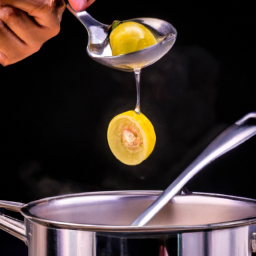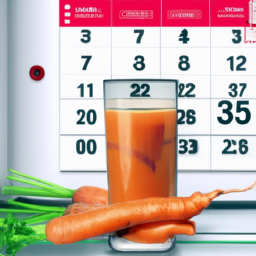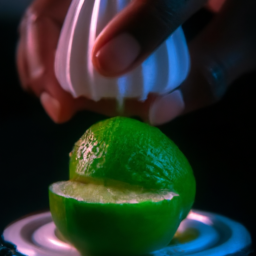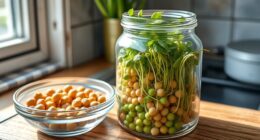I have always had a deep love for prune juice, not only because of its delicious taste but also because of its many health benefits. Prune juice acts as a natural laxative, helping to regulate digestion and improve intestinal health. It is also rich in antioxidants, vitamins, and minerals that support overall health and well-being.
In this article, I will guide you through the process of making your own prune juice, step by step. With just a few simple ingredients and some basic kitchen equipment, you can easily create a refreshing and nutritious beverage that you can enjoy any time of the day.
So, let’s get started and learn how to make prune juice at home!
Key Takeaways
- Soaking prunes is necessary to soften them and release natural sugars before making prune juice.
- The choice between juicing or blending depends on the desired texture, and straining the mixture is essential to remove unwanted pulp or seeds.
- Sweeteners like honey, stevia, maple syrup, or dates can be added to prune juice, but they are optional.
- Proper storage is crucial for maintaining freshness and quality of prune juice.
Benefits of Prune Juice
You’ll love how prune juice not only helps with digestion, but also supports your overall health and well-being. Prune juice is an excellent source of dietary fiber, which aids in digestion and promotes regular bowel movements. It also contains antioxidants that help fight off free radicals that can damage cells and lead to chronic diseases such as cancer and heart disease.
In addition, prune juice is rich in essential vitamins and minerals such as vitamin C, vitamin K, potassium, and iron. These nutrients are essential for maintaining a healthy immune system, strong bones, and healthy blood pressure levels. With its high nutritional value, prune juice is an excellent addition to any healthy diet.
Now, let’s move on to the ingredients needed to make this delicious and nutritious drink.
Ingredients Needed
To prepare, gather the necessary ingredients for this healthy beverage. Prune juice is made from dried plums that’ve been rehydrated and blended.
The ingredients needed for homemade prune juice are:
- Dried prunes
- Water
- Blender or food processor
Prunes come in different varieties, including French, Italian, and California. Each variety has its own unique flavor and nutritional value. Prunes are known for their high fiber content, which aids in digestion and can help lower cholesterol levels. They also contain potassium, iron, and vitamin A, making them a nutrient-dense food.
To prepare the prunes, the first step is to rinse them under cold water to remove any dirt or debris. Then, place the prunes in a large bowl and cover them with water to rehydrate them. Allow them to soak for at least 4 hours, or overnight for best results.
Once the prunes are soft and plump, they’re ready to be blended into a smooth and delicious juice.
Preparing the Prunes
Once the prunes have been rehydrated and soaked, they’re ready for blending into a nutritious beverage that can benefit your digestive health and overall well-being.
Soaking prunes is an essential part of the process because it softens them and helps to release their natural sugars, which makes for a more flavorful and enjoyable juice.
There are different soaking techniques you can try, such as overnight soaking or boiling them for a few minutes, depending on the variety of prunes you’re using and personal preference.
It’s important to note that there are different varieties of prunes available, each with its unique taste and texture. Some popular varieties include the French Prune, which is known for its sweet and tender flesh, and the Imperial Prune, which has a firmer texture and a slightly tart taste.
Whichever variety you choose, make sure to follow the appropriate soaking method to achieve the desired consistency and flavor.
With the prunes properly soaked, you can now move on to the next step of blending or juicing to create a delicious and nutritious drink.
Blending or Juicing
After soaking and rehydrating the prunes, the next step is blending or juicing them to create a beverage that is packed with fiber and antioxidants, helping to support a healthy gut and immune system. The choice between juicing or blending depends on personal preference and the desired texture of the final product.
Here are some things to consider when deciding between the two methods:
-
Juicing involves extracting the liquid from the prunes, leaving behind the pulp and fiber. This results in a smoother and more concentrated juice that is easier to drink quickly.
-
Blending involves pureeing the entire fruit, including the fiber and pulp. This results in a thicker and more filling juice that may be more satisfying as a meal replacement.
-
Juicing may result in a higher concentration of certain nutrients, such as vitamin C and potassium, but may also remove some of the beneficial fiber.
-
Blending may retain more of the fiber, which can help regulate digestion and promote a feeling of fullness, but may also dilute the concentration of certain nutrients.
Once the prunes have been blended or juiced to the desired consistency, the next step is to strain the mixture to remove any unwanted pulp or seeds.
Straining the Mixture
Now, you’ll want to strain the mixture to ensure a smooth and pulp-free juice that will leave you feeling refreshed and revitalized. This is an essential step in making prune juice, as the remaining solid bits can alter the texture and taste of the final product. To accomplish this, you’ll need a strainer that can effectively separate the liquid from the pulp.
There are various strainer options available, but the most commonly used are cheesecloth, a fine mesh sieve, or a juicer with a built-in strainer. Cheesecloth is a versatile tool that allows you to control the level of filtration by adjusting the number of layers used. A fine mesh sieve is another popular choice, as it can effectively remove pulp while still keeping the juice flowing smoothly. A juicer with a built-in strainer is a convenient option if you have one available, as it can save time and effort. Whichever straining technique you choose, make sure to press down on the solids to extract as much juice as possible. Once strained, the juice is ready to be enjoyed as is or further enhanced with sweeteners (optional).
Adding Sweeteners (Optional)
If you’re craving a sweeter taste, go ahead and add your preferred sweeteners to enhance the flavor of your freshly strained prune juice. Keep in mind that adding sweeteners is optional and may depend on your personal preference.
Here are some sweetener alternatives you can use:
-
Honey: A natural sweetener that’s known to have antibacterial and anti-inflammatory properties. However, it’s high in calories and should be used in moderation.
-
Stevia: A zero-calorie sweetener that’s extracted from the leaves of the Stevia plant. It’s been found to help regulate blood sugar levels and may aid in weight loss.
-
Maple syrup: A natural sweetener that’s high in antioxidants and may help reduce inflammation in the body. It’s also a good source of minerals like zinc and manganese.
-
Dates: A natural sweetener that’s high in fiber and packed with nutrients like potassium and magnesium. They’re a great alternative to refined sugar and can be easily blended into the prune juice.
It’s important to note that while sweeteners can enhance the flavor of the prune juice, they may also have health implications. Excessive consumption of sugar and artificial sweeteners has been linked to various health problems like obesity, diabetes, and heart disease. Therefore, it’s recommended to use sweeteners in moderation and opt for natural alternatives whenever possible.
As you’ve added sweeteners to your prune juice, it’s now ready for consumption. However, before you take a sip, it’s essential to know how to store it properly to prevent spoilage and maintain its freshness.
Storing the Prune Juice
If you’re planning to make prune juice in bulk, it’s crucial to know how to store it properly to ensure its quality and freshness. Long-term storage is possible, but it requires proper handling and refrigeration. Prune juice can last for up to six months if stored correctly, but it can spoil quickly if not handled properly.
When storing prune juice, it’s essential to keep it in a clean and airtight container. A glass jar or a plastic bottle with a tight-fitting lid is perfect for storing prune juice. Avoid using metal containers as they can react with the juice and affect its taste and quality. Additionally, make sure to refrigerate the juice immediately after making it to keep it fresh for a longer time. Below is a table outlining some tips for storing prune juice:
| Storing Prune Juice |
|---|
| Use a clean and airtight container |
| Avoid using metal containers |
| Refrigerate immediately after making it |
With these tips, you can keep your prune juice fresh and tasty for an extended period. In the next section, we’ll discuss some serving suggestions that can help you enjoy your prune juice even more.
Serving Suggestions
When it comes to serving prune juice, there are a few things to consider that can enhance the experience. Personally, I like to add ice to my prune juice to make it more refreshing and enjoyable.
Additionally, mixing it with other juices, like apple or cranberry, can add some complexity to the flavor and make it more palatable for those who may not enjoy the taste of prune juice on its own.
Overall, these simple serving suggestions can make a big difference in how you enjoy your prune juice.
Adding Ice
Simply grab a glass and fill it with ice before pouring in your homemade prune juice. Adding ice is a great way to chill your juice and enjoy it on a hot day. However, if you prefer not to dilute your juice with ice, there are alternatives you can try.
You could chill your juice in the fridge before serving or use frozen fruit instead of ice to keep the drink cool. It’s important to note that adding ice or any other cooling agent to your juice may affect its health benefits. Cold drinks can slow down digestion and reduce the absorption of nutrients from food.
Therefore, if you’re drinking prune juice for its digestive benefits, you may want to avoid adding ice to it. Nevertheless, if you’re just looking for a refreshing drink, adding ice is a great option that won’t compromise the taste or quality of your juice.
Next, let’s discuss how you can mix prune juice with other juices to create a delicious and nutritious blend.
Mixing with Other Juices
To create a more complex flavor profile, try blending prune juice with other juices. Juice pairing can elevate the taste of prune juice and make it more enjoyable to drink. Here are some flavor combinations that work well:
-
Apple juice: This classic combination is both sweet and tart. The sweetness of apple juice balances the tartness of prune juice.
-
Orange juice: Another popular pairing, orange juice adds a citrusy freshness to prune juice. The high vitamin C content of orange juice also complements the high fiber content of prune juice.
Experiment with different juice pairings to find your favorite flavor combination. Not only will mixing with other juices make prune juice more palatable, but it can also increase the nutritional value of your drink.
Moving onto alternative methods, one can also make prune juice by boiling dried prunes in water.
Alternative Methods
Now, let’s talk about alternative methods for making prune juice. Personally, I’ve found that using a slow cooker is a great option.
Simply combine prunes and water in the slow cooker and let it simmer on low for several hours until the prunes are soft.
Another option is using a pressure cooker, which can significantly reduce the cooking time. However, be sure to follow the manufacturer’s instructions carefully to ensure safe and effective use.
Using a Slow Cooker
When you’re using a slow cooker to make prune juice, you’ll want to start by rinsing off the prunes and placing them in the cooker with enough water to cover them.
One of the benefits of using a slow cooker is that it allows the prunes to cook slowly and evenly, which can help to preserve their nutrients and flavor.
This method also requires less attention than other methods, as the slow cooker can be left to do its job while you attend to other tasks.
In addition to making prune juice, there are many other recipes that can be made in a slow cooker, such as soups, stews, and even desserts.
Using a slow cooker can also help to save time and energy, as it requires less active cooking time and can be used to cook large quantities of food at once.
However, if you’re looking for a faster method for making prune juice, you may want to consider using a pressure cooker instead.
Using a Pressure Cooker
If you’re in a rush and want to quickly cook your prunes, a pressure cooker is a great option. Not only does it save time, but it also retains more nutrients and flavors compared to other cooking methods. In fact, pressure cooking has been shown to increase the antioxidant activity of prunes, which is beneficial for overall health.
To make prune juice using a pressure cooker, simply add prunes and water in a 1:4 ratio to the pot. Set the pressure cooker to high pressure and cook for 10-15 minutes. Once done, release the pressure and strain the mixture through a fine mesh sieve or cheesecloth. The resulting juice can be consumed as is or sweetened with honey or another natural sweetener.
Here is a table showcasing the benefits of using a pressure cooker for cooking prunes:
| Benefits of Using a Pressure Cooker for Prunes | |||
|---|---|---|---|
| Retains nutrients | Saves time | Increases antioxidant activity | Enhances flavors |
Aside from making prune juice, pressure cookers can be used to create a variety of prune-based recipes. Some examples include prune compote, prune-stuffed pork loin, and prune oatmeal cookies. The high pressure and moisture level of the pressure cooker make it an ideal cooking method for prunes, resulting in tender and flavorful dishes. Plus, the convenience of a pressure cooker allows for easy meal prep and cooking, making it a must-have appliance in any kitchen.
Frequently Asked Questions
Are there any side effects of drinking prune juice?
I have experienced no gastrointestinal problems from drinking prune juice, and evidence suggests it can help relieve constipation. However, excessive intake may cause diarrhea, gas, and bloating. Consult a healthcare provider for personalized advice.
Can I use dried prunes instead of fresh ones?
Yes, dried prunes can be used to make prune juice. They contain the same health benefits as fresh prunes, such as promoting regularity and aiding in digestion. However, they may need to be soaked before blending to achieve desired consistency.
How long does it take to make prune juice?
The duration of the prune juice making process varies based on the desired consistency. However, the best time to drink prune juice is in the morning on an empty stomach. Studies suggest that it can improve digestion and relieve constipation.
What is the nutritional value of prune juice?
Prune juice is rich in fiber, potassium, and vitamin C, aiding digestion, regulating blood pressure, and supporting immune function. Recipes vary, but blending prunes with water and lemon juice is a simple way to reap the benefits.
Can prune juice help with digestion issues?
I once compared my digestive system to a car engine. Just as a car needs oil to run smoothly, our bodies need fiber. Prune juice benefits digestion by providing fiber, but precautions for prune juice consumption include starting with small doses and drinking plenty of water.
Conclusion
In conclusion, making prune juice is a simple process that can be done at home with just a few ingredients and tools. I discovered that the benefits of prune juice are numerous, making it a great addition to any diet. From promoting digestive health to aiding in weight loss, prune juice is a versatile drink that can provide numerous health benefits.
Using the right tools and ingredients, such as high-quality prunes and a blender or juicer, can ensure that the juice is smooth and free of any unwanted bits. And for those who prefer a sweeter taste, adding natural sweeteners such as honey or agave can enhance the flavor without adding unnecessary sugars.
So why not give it a try? Making your own prune juice is a great way to reap the benefits of this nutritious drink while having the satisfaction of making it yourself. As the saying goes, "you’re what you eat"- so why not make it something healthy and delicious?
Aurelia is the Editor-in-Chief of The Graceful Kitchen, a vegan lifestyle blog that focuses on delicious, nutritious, and ethical eating. A lifelong vegan, Aurelia is passionate about sharing her love of plant-based cuisine with others. She is a regular contributor to several online and print publications, and has been interviewed by major news outlets about the benefits of a vegan diet. In her free time, Aurelia enjoys cooking, hiking, and spending time with her cats.









